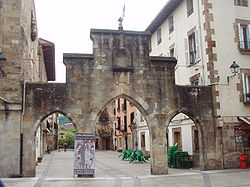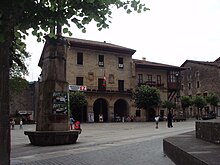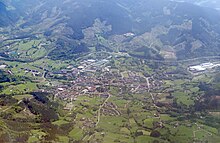Elorrio
Elorrio | ||
|---|---|---|
 An archway in Elorrio | ||
|
Postal code 48230 | ||
| Website | Official website | |
Elorrio is a town and a municipality located in the eastern part of the province of Biscay, in the Basque Country, in northern Spain. As of 2017[update], it has a population of 7,307 inhabitants.[2] It covers an area of 37.20 square kilometers and it has a population density of 193.58 people per square kilometer. It holds the medieval title of Most Loyal and Noble Villa (Spanish: Muy Noble y Muy Leal Villa).
Elorrio was founded in 1356 by the
The town has been affected by its main economic activity: the
Toponymy
In the Basque language, elorrio is the word for the red fruit (haw) of the common hawthorn. The Basque word elorri means "hawthorn". The coat of arms of the town shows a hawthorn. Colloquially, the town was called Elorrixo in Basque.
History


The Argiñeta tombs that today lie just outside the town of Elorrio are both pre-Christian and Christian (the earliest date of the latter is recorded as 893). In 1053, the San Agustín de Etxebarria monastery was founded, which in time was renovated and eventually became present-day church (an example of
As a result of this economic expansion, a number of important buildings were constructed (mostly during the sixteenth century) that are today considered monuments of significant historical and architectural importance. In the nineteenth and early twentieth centuries, Elorrio, although it remained a predominantly rural town, became a tourist destination, as people visited the locality to attend one of its two well-known spas. After the
Geography

Elorrio is located at the easternmost point of Biscay, in the comarca of Durangaldea, northern Spain. It limits at north with Berriz and Zaldibar at northwest with Abadiño, at west with Atxondo, at east with the province of Gipuzkoa and at south with the province of Álava.
The town is surrounded by various mountains, such as Intxorta (797m) and Udalatx (1092m), and is traversed by the Zumelegi river that, after joining the River Arrazola in Atxondo, goes on to form the Ibaizabal river.
The town is situated 39

Demographics
| Year | Pop. | ±% |
|---|---|---|
| 1900 | 2,776 | — |
| 1910 | 2,854 | +2.8% |
| 1920 | 3,014 | +5.6% |
| 1930 | 3,004 | −0.3% |
| 1940 | 3,077 | +2.4% |
| 1950 | 3,567 | +15.9% |
| 1960 | 4,830 | +35.4% |
| 1970 | 7,334 | +51.8% |
| 1981 | 7,857 | +7.1% |
| 1990 | 7,526 | −4.2% |
| 2000 | 7,166 | −4.8% |
| 2010 | 7,252 | +1.2% |
| 2013 | 7,294 | +0.6% |
The
Economy
The economy of the municipality is based on the industrial activity. Nonetheless, the
The most important economical activity in the area is the industry; Elorrio is home for several industries of metal processing.
Transport
The only mean of transport is by road; the BI-634 road crosses the town and connects it with
Two lines of the
Notable people
- Aniceto Sagastizabal, born in 1940 and using the name 'Gasti', had a successful career as a professional player of the Basque sport Cesta Punta (known as Jai Alai in the U.S.) from the mid-1950s thru the early 1980s in Spain, Italy, Mexico and the United States.
- Saint Balendin Berrio-Otxoa (Valentín de Berrio-Ochoa in Spanish), one of the John Paul II in 1988.[5]
- Basque Autonomous Community, 1985-1999. He was the CEO of Euskaltel, a Basque telecommunications company, until his retirement in 2011.
- Alejandro Goicoechea, born in 1895, was the engineer who developed with José Luis Oriol the Talgo railway vehicle. He died in 1984.
- Anne Igartiburu, born in 1969, is a Spanish TV presenter and actress.
- Victor Maria Bereicua, born in 1954, is a professional Jai-Alai player, who used the name 'Elorrio,' in honor of his hometown. Elorrio is famous for being the Jai-Alai player shown in the opening credits of the television series Miami Vice.
References
- ^ Municipal Register of Spain 2018. National Statistics Institute.
- INE. Retrieved 2 February 2018.
- ^ Adapted from Igor Basterretxea Kerexeta, "Elorrioko Historia" Archived 2012-02-05 at the Wayback Machine
- ^ "Padrón. Población por municipios". Archived from the original on 2016-04-20. Retrieved 2014-06-21.
- ^ See Diocese of Bilbao[permanent dead link]
External links
- ELORRIO in the Bernardo Estornés Lasa - Auñamendi Encyclopedia (Euskomedia Fundazioa) (in Spanish)
- Elorrio Official Website In Basque and Spanish

